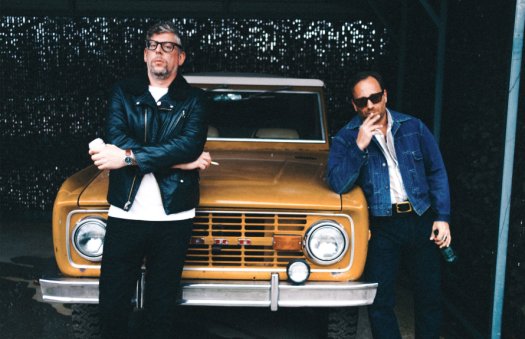More than perhaps any other genre, rock sub-categories have long been driven more by marketing and the lazy tendencies of journalists than by a scene or sound. In order to appear fresh, descriptive terms are constantly updated even if the new sounds just like the old.
What was: Alternative
Is now: Modern rock
In the mid-'80s, "alternative" meant too cool for the mainstream, from the Replacements to Skinny Puppy, from Tom Waits to Fishbone. In a "post-Nirvana" age "alternative" has become a meaningless marketing term referring to any music made by someone under 30, or that fits ubiquitous "modern rock" radio.
Alternative: The Cure, Violent Femmes, Sonic Youth
Modern rock: Alanis Morissette, Barenaked Ladies, Korn, Sarah McLachlan, Nine Inch Nails
What was: Lo-fi
Is now: Indie rock
Indie initially applied more to economics than music - meaning released by an independent label - but in the early '90s also meant a definite sound: early R.E.M. melded with the abstract aggressiveness of the Pixies. As a sound, indie rock has recently evolved to include '60s pop textures. Much early '90s indie rock was also "lo-fi," referring to primitive sound of bedroom 4-trackers, in some cases as integral to the aesthetic as an artist's financial situation. Today, the "lo-fi" fad is almost obsolete, partly due to greater accessibility to better equipment, but the fuzz flag is still flown by stalwarts like GBV's Bob Pollard.
Lo-fi: Eric's Trip, Beat Happening, Guided By Voices, Inbreds, Sebadoh
Indie rock: Pavement, Superchunk, Apples in Stereo

What was: New wave
Is now: Art rock
New wave was the poppy cousin to drearier post-punk like Joy Division, but today it refers to ambitious pop-rock of the late '70s and early '80s, which thrived on quirky creativity without the solo-centricity of prog. Because the term "new wave" is interminably linked with a certain time period and its accompanying synths and bad drum sounds, its offspring are typically termed "art rock" - diverse, ambitious rock with more emotional content than prog.
New wave: Talking Heads, XTC, Devo
Art rock: Flaming Lips, Rheostatics, Radiohead

What was: Prog and fusion
Is now: Math and post-rock
Fusion and progressive rock are both terms hijacked from their original intent by the legions of crap they spawned. Originally coined around the fusion of rock and jazz on "electric" Miles Davis albums like Bitches Brew, it came to mean synth-heavy, soulless jazz-lite, largely since abandoned by the jazz underground. Progressive rock, in the 70s, meant ambition in a different form, as rock musicians tried to follow in the Who's rock-opera footsteps, creating huge scale projects that incorporated "classical" influences, mythology, complex time signatures and absurd concept records. At its best, prog was ground-breaking; at worst, Spinal Tap. Math and post-rock are the musical offspring of prog and fusion without the lyrical absurdities. While most musicians consider both terms pretentious and inaccurate, post-rock in a post-Tortoise world has become de rigeur to describe ambitious, creative instrumental music, typically epic and often from Chicago.
Progressive & fusion: Genesis, Yes, King Crimson, Rush; 70s Miles Davis and Herbie Hancock
Math & post rock: Wooden Stars, Polvo; Tortoise, Laika, Pram
What was: Alternative
Is now: Modern rock
In the mid-'80s, "alternative" meant too cool for the mainstream, from the Replacements to Skinny Puppy, from Tom Waits to Fishbone. In a "post-Nirvana" age "alternative" has become a meaningless marketing term referring to any music made by someone under 30, or that fits ubiquitous "modern rock" radio.
Alternative: The Cure, Violent Femmes, Sonic Youth
Modern rock: Alanis Morissette, Barenaked Ladies, Korn, Sarah McLachlan, Nine Inch Nails
What was: Lo-fi
Is now: Indie rock
Indie initially applied more to economics than music - meaning released by an independent label - but in the early '90s also meant a definite sound: early R.E.M. melded with the abstract aggressiveness of the Pixies. As a sound, indie rock has recently evolved to include '60s pop textures. Much early '90s indie rock was also "lo-fi," referring to primitive sound of bedroom 4-trackers, in some cases as integral to the aesthetic as an artist's financial situation. Today, the "lo-fi" fad is almost obsolete, partly due to greater accessibility to better equipment, but the fuzz flag is still flown by stalwarts like GBV's Bob Pollard.
Lo-fi: Eric's Trip, Beat Happening, Guided By Voices, Inbreds, Sebadoh
Indie rock: Pavement, Superchunk, Apples in Stereo

What was: New wave
Is now: Art rock
New wave was the poppy cousin to drearier post-punk like Joy Division, but today it refers to ambitious pop-rock of the late '70s and early '80s, which thrived on quirky creativity without the solo-centricity of prog. Because the term "new wave" is interminably linked with a certain time period and its accompanying synths and bad drum sounds, its offspring are typically termed "art rock" - diverse, ambitious rock with more emotional content than prog.
New wave: Talking Heads, XTC, Devo
Art rock: Flaming Lips, Rheostatics, Radiohead

What was: Prog and fusion
Is now: Math and post-rock
Fusion and progressive rock are both terms hijacked from their original intent by the legions of crap they spawned. Originally coined around the fusion of rock and jazz on "electric" Miles Davis albums like Bitches Brew, it came to mean synth-heavy, soulless jazz-lite, largely since abandoned by the jazz underground. Progressive rock, in the 70s, meant ambition in a different form, as rock musicians tried to follow in the Who's rock-opera footsteps, creating huge scale projects that incorporated "classical" influences, mythology, complex time signatures and absurd concept records. At its best, prog was ground-breaking; at worst, Spinal Tap. Math and post-rock are the musical offspring of prog and fusion without the lyrical absurdities. While most musicians consider both terms pretentious and inaccurate, post-rock in a post-Tortoise world has become de rigeur to describe ambitious, creative instrumental music, typically epic and often from Chicago.
Progressive & fusion: Genesis, Yes, King Crimson, Rush; 70s Miles Davis and Herbie Hancock
Math & post rock: Wooden Stars, Polvo; Tortoise, Laika, Pram




